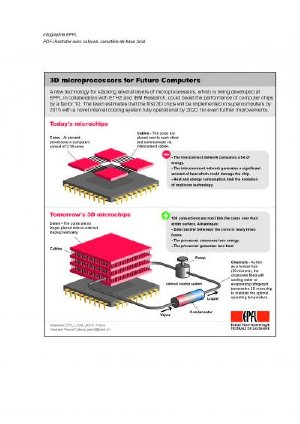Dec 11 2009
Not so long ago our computers had a single core which had to be boosted for performance - making each machine into a great central heating system. Beyond 85 degrees C, however, electronic components become unstable. To overcome this physical limit, a solution was found with the multicore technology, where the same chip includes several processors which share tasks. Most of today's consumer electronics proudly boast a "dual core" or "quad core". However, in time the technology will come up against the same physical limits.
 A new technology for stacking several layers of microprocesssors, which is being developed at EPFL in collaboration with ETHZ and IBM Research, could boost the performance of computer chips by a factor 10. The team estimates that the first 3-D chips will be implemented in supercomputers by 2015 with a novel internal cooling system fully operational by 2020, for even further improvements. Credit: Reference: EPFL, LTCM, John R. Thome; Infograph: Pascal Coderay, [email protected].
A new technology for stacking several layers of microprocesssors, which is being developed at EPFL in collaboration with ETHZ and IBM Research, could boost the performance of computer chips by a factor 10. The team estimates that the first 3-D chips will be implemented in supercomputers by 2015 with a novel internal cooling system fully operational by 2020, for even further improvements. Credit: Reference: EPFL, LTCM, John R. Thome; Infograph: Pascal Coderay, [email protected].
3D processors build on the idea of multicores. However, the cores are stacked vertically rather than placed side-by-side as in current processors. The advantage is that the entire surface of the core can be connected to the next layer, through 100 to 10,0000 connections per mm2. Shorter and more numerous, these minute interconnects should ensure that data transfer is 10 times faster, while reducing energy consumption and heat.
The Environment at Stake
The technological challenge is clear in terms of performance. But there is also an environmental stake. As John R. Thome, of the EPFL in Lausanne, explains: "In the United States, the industry's data centres already consume as much as 2% of available electricity. As consumption doubles over a five-year period, the supercomputers of 2100 would theoretically use up the whole of the USA's electrical supply!".
Although 3D microprocessors will use up less energy and generate less heat, they will still warm up. This is why John R. Thome's team is in charge of developing a revolutionary cooling system. Channels with a 50-micron diameter are inserted between each core layer. These microchannels contain a cooling liquid, which exits the circuit in the form of vapour, is brought back to the liquid state by a condenser and finally pumped back into the processor. Next year, a prototype of this cooling system will be implemented and tested under actual operating conditions - but without a processor.
CMOSAIC is evaluated scientifically by the SNSF and funded by Nano-Tera.ch with contributions of partnering institutions and industries. Six labs at EPFL, ETH Zurich and IBM also contribute to financing and are each investigating a specific aspect of the project, coordinated by John R. Thome of EPFL, on the shores of Lake Geneva.
It will take a few years until 3D microchips equip consumer electronics. The initial 3D microprocessors should be fitted on supercomputers by 2015, while the version with an integrated cooling system should go to market around 2020.